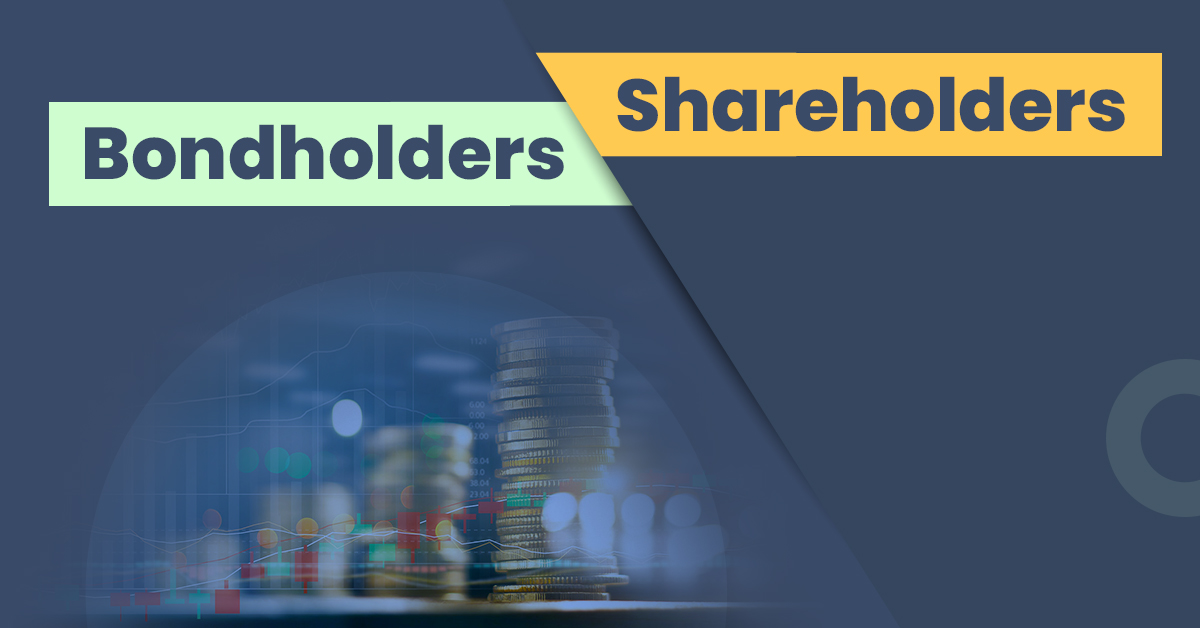What Are the Differences between Bondholders and Shareholders?


Stocks and bonds are the most common investment options for regular investors. Both serve the purpose of raising capital for their issuers and allow investors to make profits. However, these securities have fundamental differences as well as different expected returns, risks and liquidity.
Now let us learn about the differences between bondholders and shareholders.
What Are Bonds and Stocks?
Bonds are debt instruments issued by government bodies or companies against loans given by investors. The bond issuer agrees to repay the loan with interest at agreed-upon rates within a certain maturity period. Bonds are issued to raise capital for short-term or long-term duration. The main benefit of investing in bonds is their predictable returns and low risks.
On the contrary, stocks or shares are equity instruments issued by companies that give their holders fractional ownership of the company. In other words, a single share represents a unit of ownership of a company. Owning a stock can give you privileges like voting rights in shareholder meetings and a share of the company’s profits as dividends. You can also hold stocks to benefit from their capital appreciation.
Also Read: Key Differences between the Primary Market and Secondary Market
Comparison between Bonds and Shares?
Let us compare bonds and shares based on a few key factors. These are detailed in the following table:
| Basis of Comparison | Bonds | Shares |
| Type of Instrument | Debt instrument | Equity instrument |
| Investor’s Status | Lenders to the firm | Partial owners of the firm |
| Issued By | Financial institutions, public and private corporations, and government bodies | Public and private corporations |
| Participants | Retail investors, speculators, and institutional investors | Retail investors, brokers, traders, and floor traders |
| Returns | Lower | Higher |
| Type of Returns | Fixed interest income with some potential capital appreciation | Capital appreciation with some potential dividend income |
| Risk Factor | Lower in comparison to shares | Higher |
| Voting Rights | No voting rights | Have voting rights and eligibility to participate in shareholder meetings |
| Taxation | Interest income is taxed as per income tax slab rates Short-term capital gains: Income tax slab rates Long-term capital gains: 10% without indexation | Short-term capital gains: 15% Long-term capital gains: 10% over capital gains of ₹1,00,000 Dividends are taxed as per income tax slab rates |
| Where to Buy | Primary market, secondary market or Over the Counter (OTC) | Through IPO or stock exchanges |
Also Read: Everything You Want to Know about Common Stocks
What are the main Differences between Bondholders and Shareholders?
A bondholder is someone who invests in bonds issued by a company or the government. On the contrary, a shareholder is someone that owns a share of a particular corporation.
The main differences between bondholders and shareholders are given as follows:
- Status of the Holder
Bondholders are lenders or creditors of the issuing company. There are several ways a creditor can lend capital to a company, and purchasing bonds is one of the easiest and fastest ways to do so.
In contrast, shareholders are partial owners of a company. When an individual or a company purchases shares of any particular company, they acquire a percentage ownership of that specific company.
- Voting Rights
Bondholders do not have any voting rights as they lend their money in the form of bonds to the organisation for a limited time.
On the other hand, shareholders have voting rights based on their holding percentage and can participate in company meetings. However, there are some types of shares which do not carry voting rights, like, preference shares.
- Income Benefits
Bondholders do not get a share in the issuer’s profit but typically earn income in the form of interest at a fixed annual rate. These interests are paid at predetermined intervals, whether a month, quarter, half-year or a year.
In the case of shareholders, the income is based on profits in the form of dividends and capital appreciation. The income depends on the total number of shares purchased. Many companies issue rewards called dividends among shareholders in the form of cash or additional stocks (bonus shares). Other than dividends, an investor can make profits by selling stocks at a price higher than their purchase price.
- Preference of Payments
A company prioritises payment to bondholders over shareholders on the basis of payments of liabilities. This is because bondholders are eventually money lenders to an organisation and, thus, have the right to receive their interest payments first.
On the contrary, as shareholders are the partial owners of a company, the remaining profit (if any) is distributed as per the organisation’s dividend policy.
- Payment Priority during Dissolution
If a company faces dissolution or bankruptcy in its operations, all its net assets are liquidated. In such a case, the bondholders or creditors are given the priority of payments as the company is liable towards them. After clearing all debts and liability, if the company is left with some funds, they are distributed among shareholders according to their holding percentage.
- Risk Factor
Bondholders carry moderate risk. Bonds are essentially a form of a loan given to an organisation. The risk is primarily of capital default. However, this risk is comparatively lower in case of bonds that are secured by a collateral. However, in the case of shareholders, they are partial owners of the company, and they take part in meetings and operations. Hence, they are exposed to risks on the organisation’s behalf and are much more riskier than bonds.
Here is a tabular representation of the difference between bondholders and shareholders:
| Basis of Comparison | Bondholders | Shareholders |
| Holder’s Status | Creditors or lenders to the business. | Partial owners of the business. |
| Voting Rights | Do not have voting rights. | Usually, they have voting rights. |
| Income Benefits | Fixed interest income with premiums in some cases. | Dividend income with capital appreciation. |
| Payment Preference | According to the debt agreement. | According to the board of directors. |
| Payment Priority during Dissolution | First priority. | Last priority. |
| Risk Factor | Carries low to moderate risks. | Are exposed to high risks. |
Read More: Five Biggest Stock Market Myths – Debunked!
Which One Is the Better Option between Bonds and Shares?
If you want your investments to yield stable returns and want low exposure to risks, then purchasing bonds is ideal for you. Bonds give fixed interest income which are predictable, and their prices are less volatile than shares, which makes them relatively safe investments. However, bonds have a lower potential for high returns compared to stocks.
On the other hand, if you have a high-risk appetite and a long investment horizon, then shares are a better investment. They have a greater potential for offering high returns, depending on the state of the company and market conditions. However, there are high risks involved in such investment, and you may even lose your invested capital.
Also Read: Alpha in Stocks: Meaning, Importance, Benefits & Risks
Final Word
To conclude, it is very important to ascertain your risk tolerance and financial goals before investing in either bonds or shares. This is especially true if your investments involve a large sum of money. Thus, you can also consult a professional financial advisor to get guidance and avoid risk, as investing in the wrong way is not affordable. Moreover, there are various types of stocks and bonds from which you can choose as per your requirements.
Frequently Asked Questions
How to invest in bonds and stocks?
To invest in bonds and stocks online, you need to have a trading account along with a Demat account. For bonds, you can either buy directly from the issuing company, the RBI Retail Direct portal (for government bonds) or via bond platforms. You can buy shares via IPOs (Initial Public Offerings) or by putting a buy order on the stock exchange.
Is the dividend income given to the shareholders fixed?
No, dividend income given to shareholders is usually not fixed and is declared per equity share on the basis of management discretion. In addition, a company is also not obligated to distribute dividends in every financial year.
Why do shares or stocks carry more risk than bonds?
Bonds are actually a loan to a company or an entity, while stocks are partial ownership in a company. As these bonds are loans with fixed interest, face value and a maturity date, they are liable for repayment. On the other hand, shares are not liable for payment as they only provide ownership. That is why shares are riskier than bonds.
What are the risks involved while investing in bonds and stocks?
The main risks involved while investing in bonds include credit risk, liquidity risk, inflation risk and default risks . On the other hand, investment in shares can involve various types of systematic and unsystematic risks. Some of these include credit risks, market fluctuations, changes in political or economic scenarios, and more.




